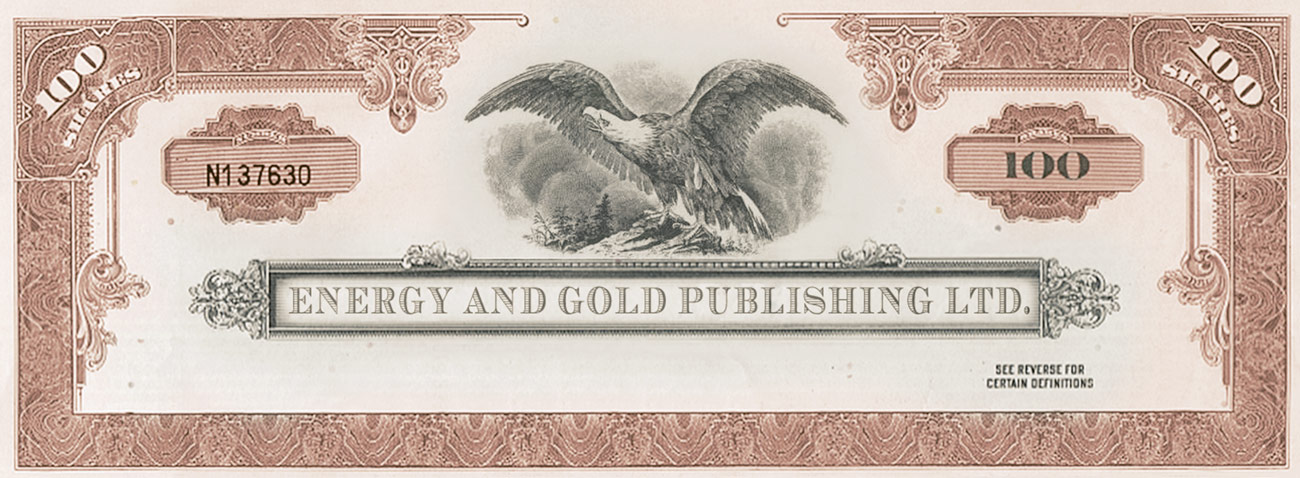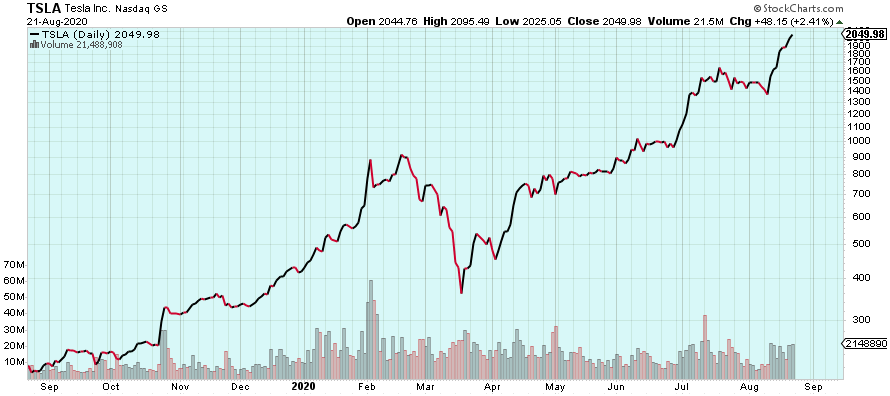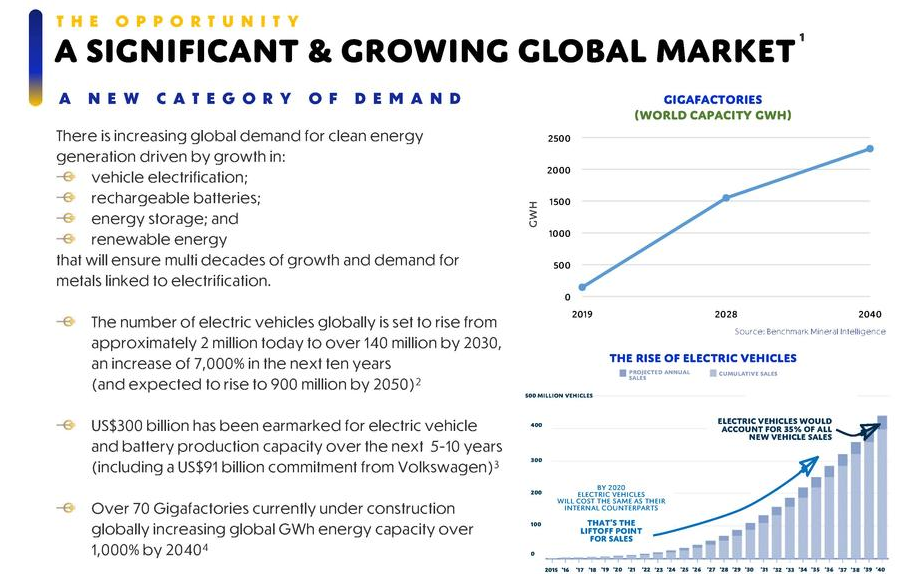One of the greatest bull market stories of the last year has been Tesla (NASDAQ:TSLA) and its relentless rise from below $200 per share in May 2019 to over $2000 per share in the last couple of weeks:
TSLA (Daily)
TSLA’s share price rise has closely tracked the acceleration in demand for electric vehicles around the world. According to Bloomberg New Energy Finance, by 2022 EVs will cost the same as their ICE (internal combustion engine) counterparts and the projected annual sales curve over the next two decades is nothing short of parabolic. Tesla has delivered ~3 million EVs in the last three years and the world’s largest electric vehicle maker just reported its first profitable quarter on GAAP basis.
A Looming Long-Term Supply Gap for Key Metals Required for Electric Vehicles
Today, the global EV fleet numbers 8.5 million vehicles, and by 2030 it is expected to be over 140 million vehicles – this is a more than 1500% increase over the next decade. In order to build the next 100+ million electric vehicles, EV producers such as Tesla will need to source a massive amount of battery metals. You can’t build an electric vehicle without lithium, nickel, copper, graphite etc. This is where a young, visionary company comes into the conversation – Electric Royalties Ltd. (TSX-V:ELEC).
We asked CEO Brendan Yurik why he is so bullish on these metals besides the obvious forecast demand growth:
“The thing that people need to understand is that mining is the most inelastic sector on the planet, it’s not something where you say you need more cobalt tomorrow and you can just turn on the tap to meet demand. The average time it takes projects to go from a discovery drill hole to commercial production is over 15 years, and that’s if everything goes right, which in mining rarely, if ever, happens. So, with a demand forecast like this with double digit growth year over year across most of these metals, it’s very hard to wrap your head around a situation whereby you don’t see a much higher equilibrium price for electric metals moving forward over the next 2 to 20 years.”
Royalty Companies – The Best Business Model in Mining
In the precious metals sector, royalty companies have long been one of the strongest investment opportunities – with companies like Franco Nevada (NYSE:FNV), Wheaton Precious Metals (NYSE:WPM), and Royal Gold (NYSE:RGLD) delivering strong returns to shareholders over the last decade despite a challenging multi-year bear market (500%-2000%+).
However, there is opportunity for royalty companies to participate in other areas of the metals mining sector, while also delivering strong returns to shareholders. Today, I am introducing a new royalty company focused on the battery metals sector. The value creation opportunity for this company doesn’t stop at electric cars, but also includes renewable energy generation and electricity storage. Electric Royalties is looking to take advantage of strong, and increasing, demand for commodities such as lithium, vanadium, manganese, tin, graphite, cobalt, nickel and copper.
Electric Metals Demand – Exponential Growth For Decades
Demand for lithium, nickel, and graphite are expected to be nothing short of parabolic over the next decade.
US$300 billion has been earmarked for electric vehicle and battery production capacity over the next 5-10 years:
Uses for these materials include cars, rechargeable batteries, large scale energy storage, renewable energy generation and other applications. ELEC has assembled a royalty portfolio of 11 projects, with plans to rapidly expand this portfolio in the future:
ELEC CEO Brendan Yurik commented that: “It’s crazy that we’re in this situation where you have had so much discussion around climate change, and electric vehicles, and going green, however no-one has really taken the time to figure out that the supply of these metals is probably the biggest risk right now for the whole electric revolution. The mining sector has been hit hard over the past ten years, and outside of the precious metals space, which is obviously doing well at the moment, there has been very minimal capital deployed to the electric metals mining sector, I don’t know the exact numbers but I would hazard a guess that for every $1 dollar invested into the oil and gas sector each year, the electric metals mining sector probably received less than half a penny. With a 15 year timeline to production, it’s not like we can just turn the tap on when these metals are needed so there is an urgent and massive need for a group like us right now to help revitalize this supply chain for the electric vehicle sector.”
Let’s start with lithium, which is used as a compact power source due to its high vitality thickness and less energized time required to recharge. Electric Royalties has secured key royalties in and around the Canada Lithium mine, one of a few lithium projects in North America to make it to production. The royalties are over several North American projects, the first being the Authier Lithium project that has great infrastructure being in close proximity to mining support services, low-cost electricity, gas, and road networks to export ports. The Bouvier & Chubb royalties are situated within the Preissac-Lacorne plutonic complex of the Abitibi Greenstone Belt, the complex forming one of the best prospective areas for lithium mineralization. The plutonic complex generated the Quebec Lithium Project located 60 kilometres north of Val dOr, Quebec.
Vanadium is a key metal for energy storage, particularly stationary energy storage. While the broader energy storage market and stationary applications is expected to grow at a CAGR of 36% between 2018 and 2027, the fastest growth rate among all three belongs to stationary energy storage (Bushveld Minerals Ltd website). The Mont Sorcier project’s property hosts a large high-quality iron resource with significant and extractable Vanadium in a top tier mining jurisdiction. Exceptionally low titanium content makes the deposit unique, as low titanium allows iron ore and vanadium processing directly through a blast furnace.
Manganese can lower the manufacturing cost of lithium-ion batteries, which is a major factor in the cost of electric vehicles. The global electrolytic manganese dioxide market size was valued at US$1.25 billion in 2018 and is expected to expand at a CAGR of 7.0% over the forecast period of 2019 to 2025. There are currently no producing manganese mines in North America, so the Battery Hill property may be the first. Consisting of 55 claims covering 1,228 hectares, it encompasses all or parts of five manganese-iron zones. Additionally, there is highway access within 3 km of the project and transmission lines run close to the property. The Plymouth deposit, which is located ~2.5 km to the southwest of the property, has an Inferred Mineral Resource of 44.8 million tonnes with an average grade of 9.85% manganese.
Cobalt is a key component of lithium ion batteries, which is integral to powering electric vehicles. Due to a global push towards sourcing ethical cobalt, Electric Royalties is targeting jurisdictions with low geopolitical risk (as the Democratic Republic of Congo currently supplies 60% of global cobalt production). Increasing supply deficits forecast beyond 2025 with base case demand projected at approximately an 83% increase. Also home to several world-class copper/gold/cobalt and lead/zinc/silver mines and deposits, Millennium Cobalt is a cobalt-copper deposit located in the well-established mining district of Mount Isa, Qld. A 2018 drill program confirmed continuity between the previously reported high-grade cobalt zones indicating wide zones of cobalt mineralisation near surface and at depth with assay results indicating metal grades exceeding prior expectations.
Graphite, used as a key component of the batteries used in electric vehicles, is produced mainly in China. But by 2023, a 20x increase in production capacity will be needed with 103 Li-Battery manufacturing plants in the pipeline. The Bissett Creek project is located approximately 10 hours away from the largest Gigafactory slated to come online in the next few years. With a potential mine life of 80 years, graphite concentrate at 94.5% will be produced from a simple flotation flow sheet with coarse grind and few polishing and cleaning steps. Bissett Creek is in the final feasibility stage with most major permits in hand – this is a project that’s ready for construction to begin shortly.
In a recent conversation CEO Brendan Yurik outlined what’s next for ELEC:
“We want to grow quickly, we closed off or signed definitive agreements on 11 royalties in July as well as closing our RTO and our going public financing for C$5.2 million in one month so we’re not sitting on our hands. Before we even started the company we spent about 4 months doing research on the supply sides for each of the various commodities including nickel, copper and tin which are equally set to benefit from the drive to electrification so you can bet that we will be going out and getting some exposure to those commodities in the near future. That said, one of our priorities at this moment is to go acquire some cash flowing or advanced stage royalties on long life assets and we’re talking to a number of groups on that front at the moment. The deals in our space are just night and day versus what you see in the precious metals space right now in terms of cost of acquisition, and we’ve found that most groups we approach are open to taking a majority of our acquisition cost in shares of Electric Royalties, It’s an exciting time.”
The Opportunity
We know there are royalty companies for other materials, but this is the first company I know of that is solely focused on battery materials. It’s a brilliant concept. With the success of Tesla and investment apps like Robinhood, there is a younger contingent of stock market investors who understand the shift to electric vehicles, battery metals, and renewable energy. ELEC will eventually attract some of these investors and I’m sure it’s no coincidence that all ELEC employees are under age 50.
The company is led by the young and hungry CEO Brendan Yurik whom has been exclusively focused on junior mining finance advisory for the past ten years with experience on over $2 billion in mining financing transactions throughout his career with Evenor Investments, Endeavour Financial, Cambrian Mining Finance Ltd, Northern Vertex Mining Corp. and King & Bay West Management Corp.
ELEC’s market cap is still relatively small at C$12 million, but this story is just getting started. This is an opportunity to invest in a visionary company at the beginning of one of the greatest bull markets of our lifetimes, the battery metals revolution.
Disclosure: Author is long ELEC shares at the time of publishing and may choose to buy or sell at any time without notice.
Disclaimer:
The article is for informational purposes only and is neither a solicitation for the purchase of securities nor an offer of securities. Readers of the article are expressly cautioned to seek the advice of a registered investment advisor and other professional advisors, as applicable, regarding the appropriateness of investing in any securities or any investment strategies, including those discussed above. Electric Royalties Ltd. is a high-risk venture stock and not suitable for most investors. Consult Electric Royalties Ltd.’s SEDAR profiles for important risk disclosures. EnergyandGold has been compensated for marketing & promotional services by Electric Royalties Ltd. so some of EnergyandGold.com’s coverage could be biased. EnergyandGold.com, EnergyandGold Publishing LTD, its writers and principals are not registered investment advisors and advice you to do your own due diligence with a licensed investment advisor prior to making any investment decisions.
This article contains certain forward-looking information and forward-looking statements within the meaning of applicable securities legislation (collectively “forward-looking statements”). Certain information contained herein constitutes “forward-looking information” under Canadian securities legislation. Generally, forward-looking information can be identified by the use of forward-looking terminology such as “expects”, “believes”, “aims to”, “plans to” or “intends to” or variations of such words and phrases or statements that certain actions, events or results “will” occur. Forward-looking statements are based on the opinions and estimates of management as of the date such statements are made and they are subject to known and unknown risks, uncertainties and other factors that may cause the actual results, level of activity, performance or achievements of the Company to be materially different from those expressed by such forward-looking statements or forward-looking information, standard transaction risks; impact of the transaction on the parties; and risks relating to financings; regulatory approvals; foreign country operations and volatile share prices. Although management of the Company has attempted to identify important factors that could cause actual results to differ materially from those contained in forward-looking statements or forward-looking information, there may be other factors that cause results not to be as anticipated, estimated or intended. There can be no assurance that such statements will prove to be accurate, as actual results and future events could differ materially from those anticipated in such statements. Actual results may differ materially from those currently anticipated in such statements. The views expressed in this publication and on the EnergyandGold website do not necessarily reflect the views of Energy and Gold Publishing LTD, publisher of EnergyandGold.com. Accordingly, readers should not place undue reliance on forward-looking statements and forward looking information. The Company does not undertake to update any forward-looking statements or forward-looking information that are incorporated by reference herein, except as required by applicable securities laws. Always thoroughly do your own due diligence and talk to a licensed investment adviser prior to making any investment decisions. Junior resource companies can easily lose 100% of their value so read company profiles on www.SEDAR.com for important risk disclosures. It’s your money and your responsibility.






